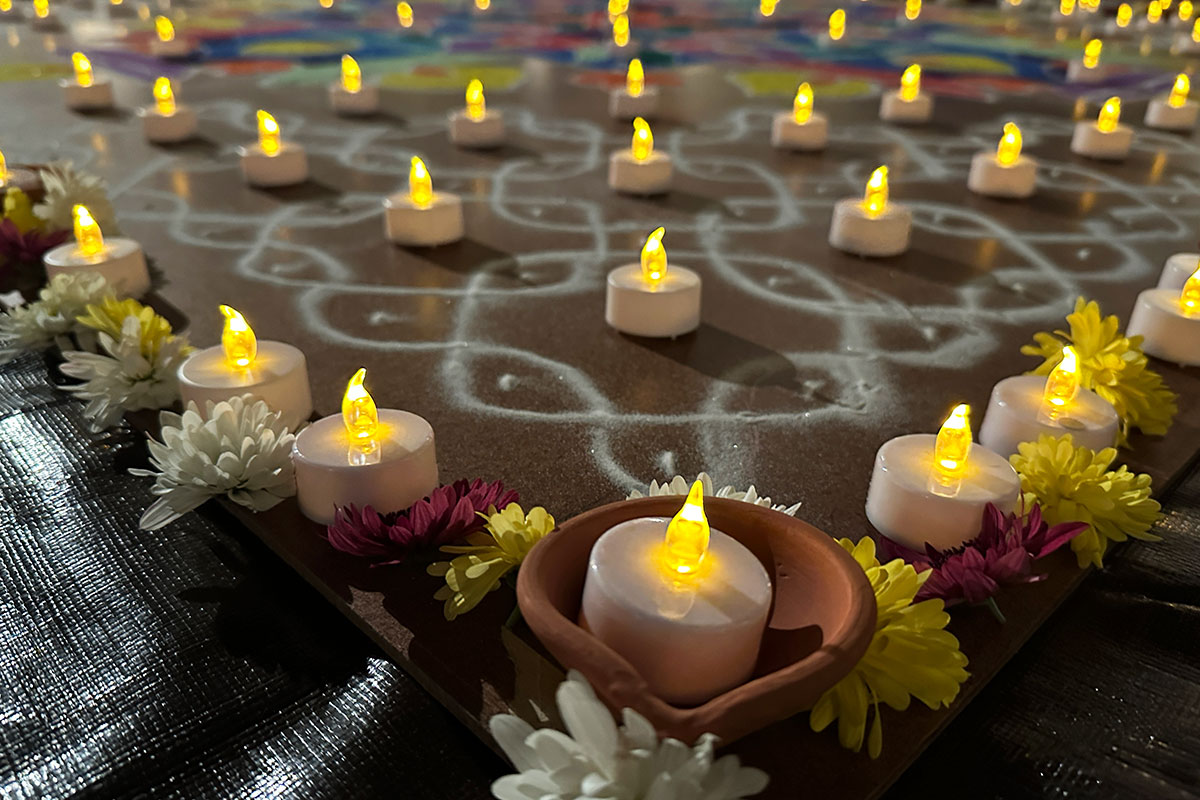Artist Shanthi Chandrasekar works in an unconventional space: “where scientific overlaps with the spiritual.” Drawing from her Indian heritage, plus an educational background in science and math, she practices painting, drawing, printmaking, and site-specific sculpture around her home in Maryland. But her specialty is kolam, a South Indian traditional decorative art form that uses rice flour, white stone powder, or chalk to create intricate geometric patterns.
Traditionally a women’s art form, kolams are usually made on the ground at the entrance of a home to bring prosperity. Each morning, artists will create a new kolam, weaving together math and meditation into a beautiful ephemeral design. By night, they may be blown or swept away: a practice in detachment and immateriality for the makers. In some ways, Chandrasekar says the form is “old social media,” signaling positive occasions and celebrations. In times of sorrow or a death in the family, the daily kolam would not be created.
In November 2023, Chandrasekar was the National Museum of Asian Art × Folklife Artisan in Residence, offering a kolam workshop and demonstration for the public. Her daughter, Aishwariya Chandrasekar, an artist and associate director of creative entrepreneurship at the Maryland Institute College of Art, assisted with the events.

Her residency coincided with the museum’s celebration of Diwali, the Hindu festival of light, with 8,000 visitors enjoying performances, music, crafts, and food. Chandrasekar designed a special kolam in the museum’s central courtyard for visitors who wanted to celebrate the holiday in a more serene space. But the quiet did not last long as a large audience grew during the two and a half hours it took the Chandrasekars to create the site-specific, symmetrical installation. Many of these attendees were small children, all of whom were mesmerized by her technique and sat quietly studying her craft.
“There are no formal courses or lessons to teach and learn kolams,” Chandrasekar explained later. “The art is learned by observation, practice, and experience. So, it was great to see very young children sit around the kolam and watch it being made. Even when some parents were wanting to leave, the kids insisted on watching. Some parents made it into a fun teaching opportunity and talked about the process and the cultural significance with their children.”
Was she distracted by the crowd? Chandrasekar shared that she has developed the discipline to focus on her design. The process is meditative, but a kolam this large took many hours of designing, sketching, and practicing. The result was a vibrant and intricate piece adorned with tea lights and flowers. Though the design was only on display until the museum closed that evening, it reached an even larger audience as attendees shared photos on social media.




“In each program that Chandrasekar led during the residency, she illuminated the beautiful intricacies of the practice of kolam, but also its inherent, embedded philosophies,” said Janis Woodward, the museum’s public programs coordinator. “I learned how to draw the dots and lines, but I also learned that it is okay to let go, it is okay to make a mistake and try again, and it is okay to be yourself. Chandrasekar said, ‘Each kolam is different, depending on the person making it.’”
Many artisans do not have time to explore away from their studios, so even though Chandrasekar lives not far from Washington, D.C., she was excited for the opportunities to visit the newly reopened National Museum of Women in the Arts, the Renwick Gallery, and the Hirshhorn Museum and Sculpture Garden. During these tours, she observed many connections to her work with repetitive shapes, hanging installations, and diverse materials.
Chandrasekar also took part in a virtual panel discussion, “Diwali Duniya: Bridging Hearts and Diyas.” Presented in partnership with Shared Studios, a New York-based company that aims to forge meaningful relationships across differences and distances, the hour-long conversation dove deep into what Diwali means and how that has changed over time. One panelist described the festival as lighting one candle and sharing the light with the next person.
The Artisan in Residency program also gives the opportunity for artists of similar practices to meet each other and share their work. On the last day of her residency, Chandrasekar met with multidisciplinary artist Julie Wolfe at her studio in the Capitol Hill neighborhood of D.C. The artists immediately connected over their practices and similar use of shapes and patterns. While they had followed each other for years and saw each other’s work, they had never met before.
Through meetings like these during residencies, the program deepens artist-to-artist connections as well as the artist-to-visitor connections made during the public programs.

Beth Ferraro is the artisan coordinator working with the Center for Folklife and Cultural Heritage and the National Museum of Asian Art Museum on this pilot program. She is the curator at Gallery Y at the YMCA Anthony Bowen in D.C., teaches chair yoga to seniors, and serves as an art and community consultant under the name The Art Island.
This program received federal support from the Asian Pacific American Initiatives Pool, administered by the Smithsonian Asian Pacific American Center.


